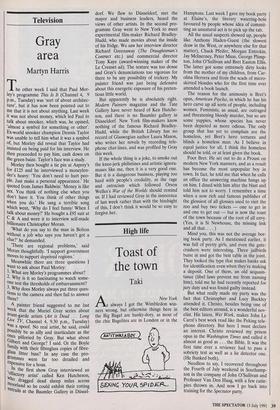Television
Gray area
Martyn Harris
The other week I said that Paul Mor- ley's programme This Is It (Channel 4, 9 P.m., Tuesday) was 'sort of about architec- ture', but it has now been pointed out to me that it is not about anything. Last week it was not about money, which led Paul to talk about snooker, which was, he opined, `almost a symbol for something or other'. Ex-world snooker champion Dennis Taylor was unable to tell him what it was a symbol of, but Morley did reveal that Taylor had insisted on being paid for his interview. He then proceeded to pay him, cash down on the green baize. Taylor's face was a study.
Morley then bought a tie pin at Asprey's for £125 and he interviewed a moneylen- der's heavy: 'You don't need to hurt peo- ple. Just make a personal appearance.' He quoted from James Baldwin: `Money is like sex. You think of nothing else when you don't have it. You think of other things when you do.' He sang a terrible song which went, `Why do I feel funny/ When I talk about money?' He bought a £95 suit at C & A and wore it to interview self-made billionaire Christopher Moran. `What do you say to the man in Bolton without a job who says you haven't got a clue?' he demanded.
`There are regional problems,' said Moran thoughtfully. 'I support government moves to support deprived regions.' Meanwhile there are three questions I want to ask about Paul Morley: 1. What are Morley's programmes about? 2. Why is it so fascinating to watch some- one test the thresholds of embarrassment? 3. Why does Morley always put three ques- tions to the camera and then fail to answer them?
A painter friend suggested to me last week that the Muriel Gray series about avant-garde artists (Art is Dead . . . Long Live TV, Channel 4, 9.30 p.m., Tuesday) Was a spoof. No real artist, he said, could Possibly be as silly and inarticulate as the ones pilloried by Gray. But what about Gilbert and George? I said. Or the Boyle family with their fibreglass copies of fibre- glass litter bins? In any case the pro- grammes were far too detailed and expensive for a hoax. , In the first show Gray interviewed an olfactory artist' called Ken Hutcheson, who dragged dead sheep miles across Moorland so he could exhibit their rotting entrails at the Baumler Gallery in Diissel- dorf. We flew to Dusseldorf, met the mayor and business leaders, heard the views of other artists. In the second pro- gramme Gray went to New York to meet experimental film-maker Richard Bradley- Hudd, who made movies about the inside of his fridge. We saw her interview director Richard Greenaway (The Draughtsman's Contract etc.) and commercial director Tony Kaye (award-winning maker of the Le Creuset ad). The texture was too dense and Gray's denunciations too vigorous for there to be any possibility of trickery. My painter friend was just being defensive about this energetic exposure of his preten- tious little world.
But apparently he is absolutely right. Modern Painters magazine and the Tate Gallery have never heard of Ken Hutche- son, and there is no Baumler gallery in Diisseldorf. New York film-makers know nothing of the famous Richard Bradley- Hudd, while the British Library has no record of Glaswegian author Laura Mason, who writes her novels by recording tele- phone chat-lines, and was profiled by Gray this week.
If the whole thing is a joke, to smoke out the knee-jerk philistines and artistic ignora- muses like me, then it is a very good one. But it is a dangerous business, playing too hard with people's credulity, as the rage and ostracism which followed Orson Welles's War of the Worlds should remind us. If I had reviewed Gray in the innocence of last week rather than with the hindsight of this, I don't think it would be so easy to forgive her.


















































 Previous page
Previous page